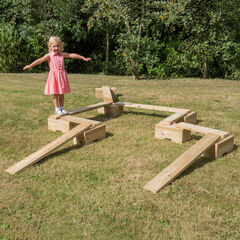As a child, building an obstacle course was always a firm favourite of mine. I remember one Sunday afternoon being in the University of Nottingham gardens. I was with with my sisters and cousin trying to build a bridge over a little stream and we wanted to continue our climbing adventures on the other side of the ‘river’. It’s only since becoming a teacher that I can look back on that and appreciate all the skills we were developing.
Building!
The building part engaged our creativity, problem solving skills, understanding of materials and I guess, basic engineering skills. It is exactly these things that I saw in the children of Crich Infant School when I observed them using our Outdoor Wooden Mini Adventure Trail.

Lifting the blocks to build the trail.
Those block sections are rather chunky and do pose a challenge but not so much of a challenge that it’s too difficult. This means even reception children can build and design their trail however they like, independent of their teachers. So already, I had witnessed a group of four and five year olds organising equipment, lifting blocks, tires and crates, working as a team and helping each other out. They were also problem solving as them came to tricky parts in putting their trail together. All of this in under ten minutes. Amazing!

Trail building or a primary school version of The Gladiators?
Leadership skills were also clearly in action as Logan assumed the role naturally. He knew what he wanted and worked with the rest of the team to get it all sorted and solve some of the problems that arose. At this early stage in his education, he’s probably not even aware of the skills he was demonstrating. However, using our Outdoor Wooden Mini Adventure Trail means that his teacher is now firmly aware of this strength in him and can look to nurture it in other areas of the curriculum.
Balancing!
Once their trail was complete it was time to start balancing! Every single child was eager to have a go. From the more confident year one children to the newly established reception children. Some bounded along, some were far more cautious. All of them tried and even when things didn’t go as they had expected, they worked out the problem, jumped back on and started again.

Thinking hard to work out what needs fixing.
My favourite thing about this session was how the older children, unprompted, regularly helped the reception children. It seemed to be instinctive, maybe because the year one children had done this before they understood that helping those who hadn’t was a natural course of action. Any resource that provides this sort of opportunity for children is worth its weight in gold in my eyes!

Year one children help reception children to conquer the more difficult parts of the trail.
This mini adventure trail also provides key physical skills too. Balancing and coordination are crucial areas of development in Key Stage 1 and 2 children.
Pupils should develop fundamental movement skills, become increasingly competent and
confident and access a broad range of opportunities to extend their agility, balance and
coordination, individually and with others. Department for Education, Physical Education, 2013
Core muscles were engaged to prevent wobbling off the planks and to help move over the seesaw. Jumping was performed in increasingly dramatic dismounts but the best muscle use of all, was those being used to create the smiles all over the children’s faces.
Boosting!
Once the children had all done a few rounds of their self created course, it was time to put away the equipment. Because the space in which they were working was limited, each piece of equipment had a specific place. It was evident the children were well versed in this and everything was put away effectively, efficiently and amiably. Teacher, Paige Farley, comments in the accompanying video that even putting the equipment away is like a game of Tetris for the children, providing even more opportunities to develop problem solving and team work skills.
Thinking back to the bridge in Nottingham University gardens, I wish I’d had access to resources such as this Outdoor Wooden Mini Adventure Trail. Who knows, I may have taken a different path in life. Maybe my confidence in my own ability would have been more secure a lot sooner. Even if none of that was the case, I know I’d have enjoyed outdoor learning time a great deal more than I remember doing.
This article was written by our Social Media and Content Manager, Katie Addison, (former teacher of English), in collaboration with Paige Farley, Year 1 teacher at Crich Infant School in Derbyshire.






